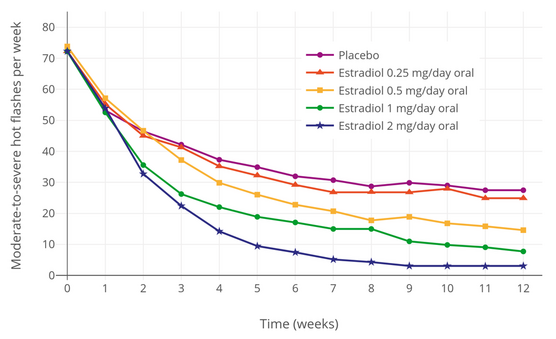Hormone Replacement Therapy
Original Editor - Habibu salisu Badamasi
Top Contributors - Habibu Salisu Badamasi, Lucinda hampton and Niha Mulla
Introduction[edit | edit source]
Hormone replacement therapy (HRT) is a treatment that relieves symptoms of menopause, by supplementing the hormones that are at a lower level.[1][2] Conventional HRT includes an estrogen and progesterone component to mimic hormones created by the human ovary.[3]
Since the 2002 Women’s Health Initiative (WHI) trials, the risks of HRT are low for healthy women less than age 60 or within ten years from menopause, has been found to be low. For women experiencing troublesome vasomotor symptoms, it can be a good solution. HRT also has a role in preventing osteoporosis in appropriate populations.[4]
HRT should only be for a few years, and close monitoring is required. When symptoms of menopause are mild, then education should be provided about the benefits and harm of these hormones.[3]
Administration[edit | edit source]
There are many estrogen and progestogen choices that can be administrated orally or transdermally either through cream, patch, vaginal inserts, or subdermal pellets. Each route of administration has unique benefits and risks.
- Oral Estrogen: Any estrogen administered orally increases the risk of a blood clot.
- Transdermal Estrogen: Bypasses the hepatic metabolism and the risk for blood clotting is negated.
- Progestin administration: usually via the oral route.[3]
Indications[edit | edit source]
The presence of bothersome vasomotor symptoms is the main indication for HRT. Vasomotor symptoms are common during the menopause transition and affect about 80% of women, and are severe in about 20% of these women. The duration of these symptoms varies, with a median of 4 to 7 years, but may continue for as many as 12 to 14 years in about 10% of women. HRT may be indicated when menopausal symptoms are adversely affecting quality of life.[1] For Symptoms of menopause see here
Benefits of hormone replacement therapy[edit | edit source]
We know now that the safety of HRT depends on a woman’s age and length of time since menopause. As such the benefits tend to outweigh the risks in healthy women less than age 60 or within ten years from menopause. There are various types, formulations and routes of HRT available to women so that their healthcare practitioner can fashion their treatment to manage their symptoms.[4]
- Relieves hot flashes and night sweats
- Helps better sleep
- Ease vaginal dryness and itching
- Makes sex less painful
- Helps prevent fractures caused by osteoporosis
- Make some women less likely to have heart disease
- Lowers chances of dementia
- Taking HRT around the time of menopause reduces a woman’s risk of developing diabetes
- HRT slightly reduces the risk of colorectal/bowl cancer.
Watch this 22 minute video for an up to date indepth look at this issue (23 minutes)
Risks of hormone replacement therapy.[edit | edit source]
The largest clinical trial to date, hormone replacement therapy that consisted of an estrogen-progestin (progestin is the synthetic form of progesterone, natural progesterone is a better choice of medication) pill increased the risk of certain serious conditions, including:[6]
- Heart disease
- Stroke
- Blood clots
- Breast cancer
- Endometrial cancer, if patient takes estrogen without progesterone while still having a uterus.
- Venous thrombosis
Variables:
- Age: Women who start treatment earlier as symptoms appear are at low risk of side effects where as women who start HRT later for example 10 years after menopause are at the higher risk of developing side effects.
- Type of hormone therapy: HRT with both estrogen and progesterone is a safer choice, rather than only estrogen.
- History: Family and personal medical history of cancer, heart disease, stroke, blood clots, liver disease and osteoporosis play a role in deciding if HRT is a good or bad option for an individual.
- Patient should take the lowest does of medication that suits them.
- Patient should undergo regular mammograms and pelvic exams.
References[edit | edit source]
- ↑ 1.0 1.1 Hickey M, Elliott J, Davison SL. Hormone replacement therapy. Bmj. 2012 Feb 16;344.
- ↑ Sullivan SD, Sarrel PM, Nelson LM. Hormone replacement therapy in young women with primary ovarian insufficiency and early menopause. Fertility and sterility. 2016 Dec 1;106(7):1588-99.
- ↑ 3.0 3.1 3.2 Harper-Harrison G, Shanahan MM. Hormone Replacement Therapy. InStatPearls [Internet] 2022 Feb 17. StatPearls Publishing. Available:https://www.ncbi.nlm.nih.gov/books/NBK493191/ (accessed 21.12.2022)
- ↑ 4.0 4.1 Mehta J, Kling JM, Manson JE. Risks, benefits, and treatment modalities of menopausal hormone therapy: current concepts. Frontiers in Endocrinology. 2021 Mar 26;12:564781. Available: https://www.frontiersin.org/articles/10.3389/fendo.2021.564781/full(accessed 21.12.2022)
- ↑ Peter Attia MD Menstruation, Menopause, and Hormone Replacement Therapy for Women Available from https://www.youtube.com/watch?v=uEZpg0n7jcY Accessed on 22.12.2022
- ↑ Grimes DA, Lobo RA. Perspectives on the Women’s Health Initiative trial of hormone replacement therapy. Obstetrics & Gynecology. 2002 Dec 1;100(6):1344-53.








